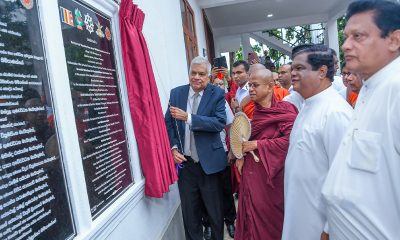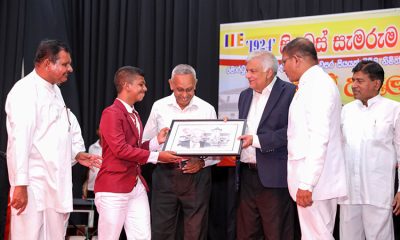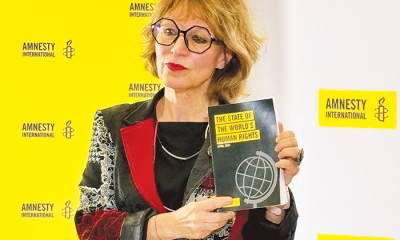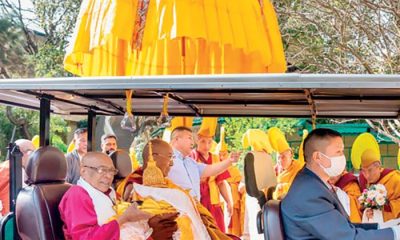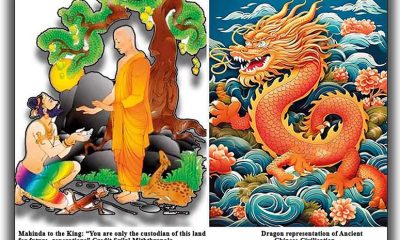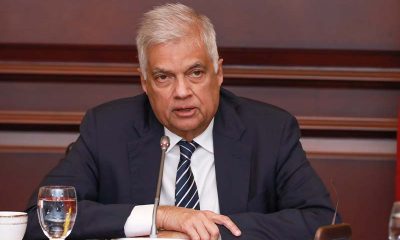Features
In Search of Buddha
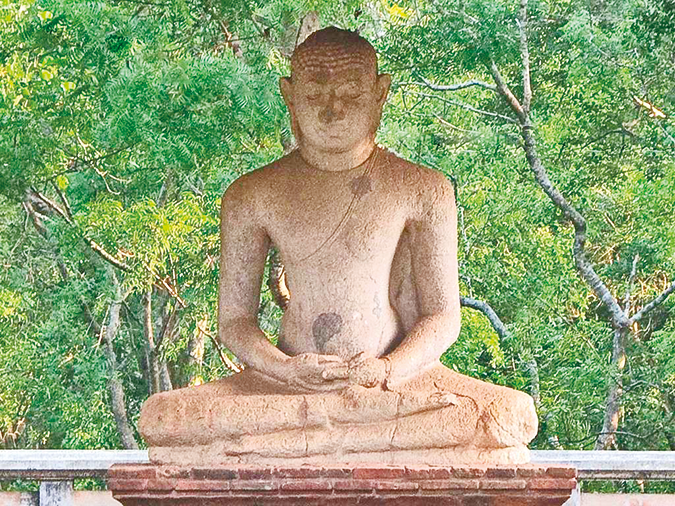
by Nilantha Ilangamuwa
Within specific communities, there exists a committed cohort of individuals who tirelessly endeavor to protect and preserve the essence of Buddhism. Employing a diverse array of strategies, they work diligently to safeguard the teachings of this ancient philosophy. Some individuals strive to accumulate significant material resources as a means of showcasing their political connections and prestige. Others claim to be committed to upholding the Buddha Dharma, employing various media tools to disseminate its teachings, albeit in a manner that may come across as uninspiring to some. In contrast, there is also a group that attempts to convey their level of understanding by satirizing events rooted in Buddhism. Unfortunately, it has not been uncommon for religious facts to be trivialized and transformed into comedy, not only in Sri Lanka but in numerous other countries. This trend extends beyond Buddhism, affecting multiple religions worldwide.
Embracing a profound philosophy like Buddhism requires significant dedication and effort from the individual practitioner. However, it is comparatively easier to gain social attention by proclaiming a dedication to protecting Buddhism from both visible and invisible threats or by criticizing and ridiculing aspects associated with a particular religion. Furthermore, such actions can be directly or indirectly employed to enhance one’s economic standing within a short period, essentially becoming a way of life. These are tactical maneuvers that have been utilized by various groups over time.
The crucial aspect to consider here is how individuals ought to conduct themselves in accordance with the principles of Dharma. It is imperative to apply the tenets of Dharma in one’s life and to genuinely comprehend its underlying truths. The preservation of Dharma lies in its adherence. A true follower of Dharma naturally imparts its principles to others within society. This was also the final request of Gautama Buddha when he introduced the Buddha Dharma to the world. Dharma holds significance in its practical application and not in distorting its principles to fulfill personal desires. This, in essence, is the fundamental truth.
In this article, the primary focus will be on the revolutionary impact Buddhism had on Western science at a time when many Eastern countries were misinterpreting the Dharma. Through the study of Buddhism, Western intellectuals gained insights into the profound transformation of human perception. While certain fundamental aspects of Buddhism as an art form were transmitted to the West, its deeper truths were subsequently subjected to the scrutiny of Western science.
Even before Alexander the Great’s conquest of Asia, Greek artists and sculptors were depicting the human form in stone and metal, incorporating them into their beliefs. However, until approximately four hundred years after Gautama Buddha’s Great Parinirvana (nirvana-after-death), only symbols such as footprints, empty thrones, lotus flowers, and the Dharma Chakra were utilized to represent the Buddha. Buddhist communities were cautious not to create any images that were intended to resemble him, prioritizing the teachings of the dharma instead. These symbols reflected the Buddha’s teachings of emptiness and liberation from attachments.
However, when Alexander the Great invaded northern Pakistan and eastern Afghanistan (known as Gandhara at the time) in 327 BC and reached the northwestern borders of India, significant changes took place. It was during this period that the Indo-Greek descendants of Alexander’s army, who had settled in Gandhara and formed families with local women after the war, introduced an image believed to depict the face of Gautama Buddha into their artistic designs. It is said that the Greeks, who had a tradition of creating godlike images resembling humans, initially fashioned the image of the Buddha based on the depictions of Apollo, a god in Greek mythology. Apollo, the son of Zeus and Leto, was the twin brother of Artemis, and he was revered as the god of healing, medicine, archery, music, poetry, and the sun. Once the image, believed to represent the Buddha, was created, it quickly gained popularity, and other communities gradually incorporated it into their artwork.
According to historical evidence, areas such as Mathura, located approximately 180 km away from Delhi, and Sarnath, around 860 km away, saw the emergence of artworks depicting the image of the Buddha. Over time, these depictions gradually departed from Greek characteristics and assumed a local form to resonate with the respective communities. This progression laid the foundation for the creation of the colossal 71-meter-high Leshan Buddha statue in China. A significant revival of this artistic tradition occurred during the reign of King Ashoka, who strategically utilized these depictions to expand his influence across the region, attracting followers from various faiths. Additionally, with the gradual development of written language, not only did texts about the Buddha Dharma emerge, but documentation of other religions also became prevalent.
Unfortunately, numerous invasions that followed resulted in the destruction of countless invaluable Buddhist scriptures and compositions. For instance, Nalanda University in Bihar, known as one of the greatest centers of knowledge, housed nearly nine million handwritten books and manuscripts. Tragically, the library was set ablaze and burned for three months during these invasions. Consequently, numerous crucial aspects of the Dharma were lost, creating an environment conducive to the proliferation of fraudulent individuals who spread hatred under the guise of protecting the Dharma, as well as empty opportunists who mocked the principles of the Dharma and associated events. Both these groups have become symbols of the profit-driven market of multifaceted heroism.
In contrast, Western science adopted a different approach when engaging with this knowledge. Despite committing massive genocides and plundering in their quest to propagate their own beliefs, certain segments in Western societies realized the importance of investing in the acquisition of knowledge from other civilizations at a state level. This led to the implementation of robust state policies in pursuit of such knowledge, including a focus on the Buddha’s Dharma. They recognized the tremendous potential for achieving remarkable results by combining Eastern wisdom with Western technology, and indeed, the outcomes were remarkable.
Prominent figures in the field of neuroscience and psychology have acknowledged the value of incorporating Buddhist practices into their research. For instance, Robert D. Truog, from Harvard Medical School, reviews the work of neuropsychologist Rick Hansen, “Buddha’s Brain” and states that recent advancements in psychology and neuroscience provide a clear understanding of how our brains function and how neural activity shapes our perception of the world. He highlights that these insights have been refined over thousands of years within the contemplative tradition of meditation. Similarly, Professor Jerome Engel from the University of California, Los Angeles, notes that neuroscientists increasingly incorporate personal reflection and introspection into their research, and Buddhist practices of deep contemplation align well with this approach, providing an opportunity to explore the workings of the brain.
Marvin Lee Minsky, a renowned cognitive and computer scientist from the Massachusetts Institute of Technology, emphasizes that the primary function of the brain is to bring about changes within itself, a phenomenon known as neuroplasticity. The brain, weighing approximately three pounds, is the most complex object known to us, consisting of around 1.1 trillion cells, including 100 billion neurons. Each neuron typically receives around five thousand connections, known as synapses, from other neurons. Every nerve signal represents information, and the nervous system functions to transmit this information, much like how the circulatory system transports blood. Millions of years of brain evolution have resulted in new abilities and adaptations that enable us to thrive in various environments.
As Rick Hansen emphasizes, the thoughts that pass through our minds are embodied by our brains. This understanding allows us to utilize our minds to bring about positive changes in our brains, benefiting not only ourselves but also everyone we interact with. This realization aligns with the teachings of the Buddha, who comprehended the intricate connection between the mind and the brain.
It is not knowledge bestowed upon us by an unknown power or deity but a profound understanding attained by the Buddha through directing his own mind with noble dedication. Therefore, to seek the Buddha is to seek his Dharma, and the initial step involves comprehending the inseparable link between the mind and the brain.
Features
The heart-friendly health minister

by Dr Gotabhya Ranasinghe
Senior Consultant Cardiologist
National Hospital Sri Lanka
When we sought a meeting with Hon Dr. Ramesh Pathirana, Minister of Health, he graciously cleared his busy schedule to accommodate us. Renowned for his attentive listening and deep understanding, Minister Pathirana is dedicated to advancing the health sector. His openness and transparency exemplify the qualities of an exemplary politician and minister.
Dr. Palitha Mahipala, the current Health Secretary, demonstrates both commendable enthusiasm and unwavering support. This combination of attributes makes him a highly compatible colleague for the esteemed Minister of Health.
Our discussion centered on a project that has been in the works for the past 30 years, one that no other minister had managed to advance.
Minister Pathirana, however, recognized the project’s significance and its potential to revolutionize care for heart patients.
The project involves the construction of a state-of-the-art facility at the premises of the National Hospital Colombo. The project’s location within the premises of the National Hospital underscores its importance and relevance to the healthcare infrastructure of the nation.
This facility will include a cardiology building and a tertiary care center, equipped with the latest technology to handle and treat all types of heart-related conditions and surgeries.
Securing funding was a major milestone for this initiative. Minister Pathirana successfully obtained approval for a $40 billion loan from the Asian Development Bank. With the funding in place, the foundation stone is scheduled to be laid in September this year, and construction will begin in January 2025.
This project guarantees a consistent and uninterrupted supply of stents and related medications for heart patients. As a result, patients will have timely access to essential medical supplies during their treatment and recovery. By securing these critical resources, the project aims to enhance patient outcomes, minimize treatment delays, and maintain the highest standards of cardiac care.
Upon its fruition, this monumental building will serve as a beacon of hope and healing, symbolizing the unwavering dedication to improving patient outcomes and fostering a healthier society.We anticipate a future marked by significant progress and positive outcomes in Sri Lanka’s cardiovascular treatment landscape within the foreseeable timeframe.
Features
A LOVING TRIBUTE TO JESUIT FR. ALOYSIUS PIERIS ON HIS 90th BIRTHDAY

by Fr. Emmanuel Fernando, OMI
Jesuit Fr. Aloysius Pieris (affectionately called Fr. Aloy) celebrated his 90th birthday on April 9, 2024 and I, as the editor of our Oblate Journal, THE MISSIONARY OBLATE had gone to press by that time. Immediately I decided to publish an article, appreciating the untiring selfless services he continues to offer for inter-Faith dialogue, the renewal of the Catholic Church, his concern for the poor and the suffering Sri Lankan masses and to me, the present writer.
It was in 1988, when I was appointed Director of the Oblate Scholastics at Ampitiya by the then Oblate Provincial Fr. Anselm Silva, that I came to know Fr. Aloy more closely. Knowing well his expertise in matters spiritual, theological, Indological and pastoral, and with the collaborative spirit of my companion-formators, our Oblate Scholastics were sent to Tulana, the Research and Encounter Centre, Kelaniya, of which he is the Founder-Director, for ‘exposure-programmes’ on matters spiritual, biblical, theological and pastoral. Some of these dimensions according to my view and that of my companion-formators, were not available at the National Seminary, Ampitiya.
Ever since that time, our Oblate formators/ accompaniers at the Oblate Scholasticate, Ampitiya , have continued to send our Oblate Scholastics to Tulana Centre for deepening their insights and convictions regarding matters needed to serve the people in today’s context. Fr. Aloy also had tried very enthusiastically with the Oblate team headed by Frs. Oswald Firth and Clement Waidyasekara to begin a Theologate, directed by the Religious Congregations in Sri Lanka, for the contextual formation/ accompaniment of their members. It should very well be a desired goal of the Leaders / Provincials of the Religious Congregations.
Besides being a formator/accompanier at the Oblate Scholasticate, I was entrusted also with the task of editing and publishing our Oblate journal, ‘The Missionary Oblate’. To maintain the quality of the journal I continue to depend on Fr. Aloy for his thought-provoking and stimulating articles on Biblical Spirituality, Biblical Theology and Ecclesiology. I am very grateful to him for his generous assistance. Of late, his writings on renewal of the Church, initiated by Pope St. John XX111 and continued by Pope Francis through the Synodal path, published in our Oblate journal, enable our readers to focus their attention also on the needed renewal in the Catholic Church in Sri Lanka. Fr. Aloy appreciated very much the Synodal path adopted by the Jesuit Pope Francis for the renewal of the Church, rooted very much on prayerful discernment. In my Religious and presbyteral life, Fr.Aloy continues to be my spiritual animator / guide and ongoing formator / acccompanier.
Fr. Aloysius Pieris, BA Hons (Lond), LPh (SHC, India), STL (PFT, Naples), PhD (SLU/VC), ThD (Tilburg), D.Ltt (KU), has been one of the eminent Asian theologians well recognized internationally and one who has lectured and held visiting chairs in many universities both in the West and in the East. Many members of Religious Congregations from Asian countries have benefited from his lectures and guidance in the East Asian Pastoral Institute (EAPI) in Manila, Philippines. He had been a Theologian consulted by the Federation of Asian Bishops’ Conferences for many years. During his professorship at the Gregorian University in Rome, he was called to be a member of a special group of advisers on other religions consulted by Pope Paul VI.
Fr. Aloy is the author of more than 30 books and well over 500 Research Papers. Some of his books and articles have been translated and published in several countries. Among those books, one can find the following: 1) The Genesis of an Asian Theology of Liberation (An Autobiographical Excursus on the Art of Theologising in Asia, 2) An Asian Theology of Liberation, 3) Providential Timeliness of Vatican 11 (a long-overdue halt to a scandalous millennium, 4) Give Vatican 11 a chance, 5) Leadership in the Church, 6) Relishing our faith in working for justice (Themes for study and discussion), 7) A Message meant mainly, not exclusively for Jesuits (Background information necessary for helping Francis renew the Church), 8) Lent in Lanka (Reflections and Resolutions, 9) Love meets wisdom (A Christian Experience of Buddhism, 10) Fire and Water 11) God’s Reign for God’s poor, 12) Our Unhiddden Agenda (How we Jesuits work, pray and form our men). He is also the Editor of two journals, Vagdevi, Journal of Religious Reflection and Dialogue, New Series.
Fr. Aloy has a BA in Pali and Sanskrit from the University of London and a Ph.D in Buddhist Philosophy from the University of Sri Lankan, Vidyodaya Campus. On Nov. 23, 2019, he was awarded the prestigious honorary Doctorate of Literature (D.Litt) by the Chancellor of the University of Kelaniya, the Most Venerable Welamitiyawe Dharmakirthi Sri Kusala Dhamma Thera.
Fr. Aloy continues to be a promoter of Gospel values and virtues. Justice as a constitutive dimension of love and social concern for the downtrodden masses are very much noted in his life and work. He had very much appreciated the commitment of the late Fr. Joseph (Joe) Fernando, the National Director of the Social and Economic Centre (SEDEC) for the poor.
In Sri Lanka, a few religious Congregations – the Good Shepherd Sisters, the Christian Brothers, the Marist Brothers and the Oblates – have invited him to animate their members especially during their Provincial Congresses, Chapters and International Conferences. The mainline Christian Churches also have sought his advice and followed his seminars. I, for one, regret very much, that the Sri Lankan authorities of the Catholic Church –today’s Hierarchy—- have not sought Fr.
Aloy’s expertise for the renewal of the Catholic Church in Sri Lanka and thus have not benefited from the immense store of wisdom and insight that he can offer to our local Church while the Sri Lankan bishops who governed the Catholic church in the immediate aftermath of the Second Vatican Council (Edmund Fernando OMI, Anthony de Saram, Leo Nanayakkara OSB, Frank Marcus Fernando, Paul Perera,) visited him and consulted him on many matters. Among the Tamil Bishops, Bishop Rayappu Joseph was keeping close contact with him and Bishop J. Deogupillai hosted him and his team visiting him after the horrible Black July massacre of Tamils.
Features
A fairy tale, success or debacle

Sri Lanka-Singapore Free Trade Agreement
By Gomi Senadhira
senadhiragomi@gmail.com
“You might tell fairy tales, but the progress of a country cannot be achieved through such narratives. A country cannot be developed by making false promises. The country moved backward because of the electoral promises made by political parties throughout time. We have witnessed that the ultimate result of this is the country becoming bankrupt. Unfortunately, many segments of the population have not come to realize this yet.” – President Ranil Wickremesinghe, 2024 Budget speech
Any Sri Lankan would agree with the above words of President Wickremesinghe on the false promises our politicians and officials make and the fairy tales they narrate which bankrupted this country. So, to understand this, let’s look at one such fairy tale with lots of false promises; Ranil Wickremesinghe’s greatest achievement in the area of international trade and investment promotion during the Yahapalana period, Sri Lanka-Singapore Free Trade Agreement (SLSFTA).
It is appropriate and timely to do it now as Finance Minister Wickremesinghe has just presented to parliament a bill on the National Policy on Economic Transformation which includes the establishment of an Office for International Trade and the Sri Lanka Institute of Economics and International Trade.
Was SLSFTA a “Cleverly negotiated Free Trade Agreement” as stated by the (former) Minister of Development Strategies and International Trade Malik Samarawickrama during the Parliamentary Debate on the SLSFTA in July 2018, or a colossal blunder covered up with lies, false promises, and fairy tales? After SLSFTA was signed there were a number of fairy tales published on this agreement by the Ministry of Development Strategies and International, Institute of Policy Studies, and others.
However, for this article, I would like to limit my comments to the speech by Minister Samarawickrama during the Parliamentary Debate, and the two most important areas in the agreement which were covered up with lies, fairy tales, and false promises, namely: revenue loss for Sri Lanka and Investment from Singapore. On the other important area, “Waste products dumping” I do not want to comment here as I have written extensively on the issue.
1. The revenue loss
During the Parliamentary Debate in July 2018, Minister Samarawickrama stated “…. let me reiterate that this FTA with Singapore has been very cleverly negotiated by us…. The liberalisation programme under this FTA has been carefully designed to have the least impact on domestic industry and revenue collection. We have included all revenue sensitive items in the negative list of items which will not be subject to removal of tariff. Therefore, 97.8% revenue from Customs duty is protected. Our tariff liberalisation will take place over a period of 12-15 years! In fact, the revenue earned through tariffs on goods imported from Singapore last year was Rs. 35 billion.
The revenue loss for over the next 15 years due to the FTA is only Rs. 733 million– which when annualised, on average, is just Rs. 51 million. That is just 0.14% per year! So anyone who claims the Singapore FTA causes revenue loss to the Government cannot do basic arithmetic! Mr. Speaker, in conclusion, I call on my fellow members of this House – don’t mislead the public with baseless criticism that is not grounded in facts. Don’t look at petty politics and use these issues for your own political survival.”
I was surprised to read the minister’s speech because an article published in January 2018 in “The Straits Times“, based on information released by the Singaporean Negotiators stated, “…. With the FTA, tariff savings for Singapore exports are estimated to hit $10 million annually“.
As the annual tariff savings (that is the revenue loss for Sri Lanka) calculated by the Singaporean Negotiators, Singaporean $ 10 million (Sri Lankan rupees 1,200 million in 2018) was way above the rupees’ 733 million revenue loss for 15 years estimated by the Sri Lankan negotiators, it was clear to any observer that one of the parties to the agreement had not done the basic arithmetic!
Six years later, according to a report published by “The Morning” newspaper, speaking at the Committee on Public Finance (COPF) on 7th May 2024, Mr Samarawickrama’s chief trade negotiator K.J. Weerasinghehad had admitted “…. that forecasted revenue loss for the Government of Sri Lanka through the Singapore FTA is Rs. 450 million in 2023 and Rs. 1.3 billion in 2024.”
If these numbers are correct, as tariff liberalisation under the SLSFTA has just started, we will pass Rs 2 billion very soon. Then, the question is how Sri Lanka’s trade negotiators made such a colossal blunder. Didn’t they do their basic arithmetic? If they didn’t know how to do basic arithmetic they should have at least done their basic readings. For example, the headline of the article published in The Straits Times in January 2018 was “Singapore, Sri Lanka sign FTA, annual savings of $10m expected”.
Anyway, as Sri Lanka’s chief negotiator reiterated at the COPF meeting that “…. since 99% of the tariffs in Singapore have zero rates of duty, Sri Lanka has agreed on 80% tariff liberalisation over a period of 15 years while expecting Singapore investments to address the imbalance in trade,” let’s turn towards investment.
Investment from Singapore
In July 2018, speaking during the Parliamentary Debate on the FTA this is what Minister Malik Samarawickrama stated on investment from Singapore, “Already, thanks to this FTA, in just the past two-and-a-half months since the agreement came into effect we have received a proposal from Singapore for investment amounting to $ 14.8 billion in an oil refinery for export of petroleum products. In addition, we have proposals for a steel manufacturing plant for exports ($ 1 billion investment), flour milling plant ($ 50 million), sugar refinery ($ 200 million). This adds up to more than $ 16.05 billion in the pipeline on these projects alone.
And all of these projects will create thousands of more jobs for our people. In principle approval has already been granted by the BOI and the investors are awaiting the release of land the environmental approvals to commence the project.
I request the Opposition and those with vested interests to change their narrow-minded thinking and join us to develop our country. We must always look at what is best for the whole community, not just the few who may oppose. We owe it to our people to courageously take decisions that will change their lives for the better.”
According to the media report I quoted earlier, speaking at the Committee on Public Finance (COPF) Chief Negotiator Weerasinghe has admitted that Sri Lanka was not happy with overall Singapore investments that have come in the past few years in return for the trade liberalisation under the Singapore-Sri Lanka Free Trade Agreement. He has added that between 2021 and 2023 the total investment from Singapore had been around $162 million!
What happened to those projects worth $16 billion negotiated, thanks to the SLSFTA, in just the two-and-a-half months after the agreement came into effect and approved by the BOI? I do not know about the steel manufacturing plant for exports ($ 1 billion investment), flour milling plant ($ 50 million) and sugar refinery ($ 200 million).
However, story of the multibillion-dollar investment in the Petroleum Refinery unfolded in a manner that would qualify it as the best fairy tale with false promises presented by our politicians and the officials, prior to 2019 elections.
Though many Sri Lankans got to know, through the media which repeatedly highlighted a plethora of issues surrounding the project and the questionable credentials of the Singaporean investor, the construction work on the Mirrijiwela Oil Refinery along with the cement factory began on the24th of March 2019 with a bang and Minister Ranil Wickremesinghe and his ministers along with the foreign and local dignitaries laid the foundation stones.
That was few months before the 2019 Presidential elections. Inaugurating the construction work Prime Minister Ranil Wickremesinghe said the projects will create thousands of job opportunities in the area and surrounding districts.
The oil refinery, which was to be built over 200 acres of land, with the capacity to refine 200,000 barrels of crude oil per day, was to generate US$7 billion of exports and create 1,500 direct and 3,000 indirect jobs. The construction of the refinery was to be completed in 44 months. Four years later, in August 2023 the Cabinet of Ministers approved the proposal presented by President Ranil Wickremesinghe to cancel the agreement with the investors of the refinery as the project has not been implemented! Can they explain to the country how much money was wasted to produce that fairy tale?
It is obvious that the President, ministers, and officials had made huge blunders and had deliberately misled the public and the parliament on the revenue loss and potential investment from SLSFTA with fairy tales and false promises.
As the president himself said, a country cannot be developed by making false promises or with fairy tales and these false promises and fairy tales had bankrupted the country. “Unfortunately, many segments of the population have not come to realize this yet”.
(The writer, a specialist and an activist on trade and development issues . )


